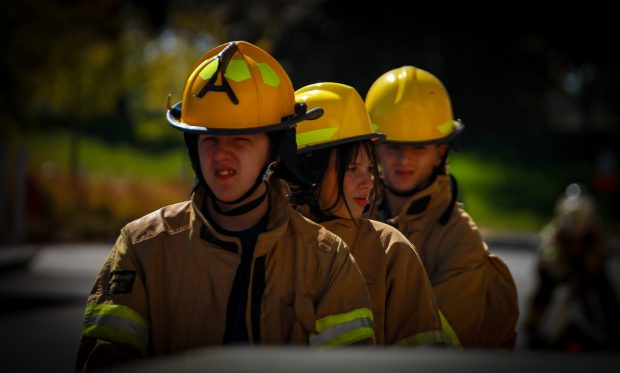
“Let’s go!” cheered the high school students of the Fire Service II class, clapping as their classmates quickly pulled in over 50 feet of rope, climbed up and down a ladder, then ascended three flights of stairs, all while wearing 60 pounds of gear.
Thanks to a $400,000 grant from the state of Idaho, students enrolled in the fire services program in West Ada School District will receive 29 items of hands-on firefighting equipment like a thermal imaging camera, combat fire hoses and a forcible entry container. Course instructor Kent Hemseri, a retired firefighter with 30 years of experience, says the grant will empower students through exposure to vital firefighting techniques, preparing them for future careers.
The program is offered by West Ada’s Career and Technical Education (CTE) pathway, which has over 20 options for students looking for skills-based programs. The grant received by the fire service program is part of Gov. Brad Little’s “Leading Idaho” initiative, and comes at a time when state superintendent Debbie Critchfield is also prioritizing increases in CTE funding, hoping to prepare students for life after high school.
Hemseri paused often during the training to motivate the students yelling, “take your time,” “use your legs not your back” and “one step at a time.”
Currently 140 students from seven different high schools participate in fire services courses including, Orientation to Police, Fire, & Emergency Medical Services, Fire Service I and Fire Service II. Hemseri explained that students who finish the program walk away prepared to attend a fire academy after high school and also receive certifications that improve their resumes through organizations like the National Wildlife Coordination Group (NWCG) and the Federal Emergency Management Agency (FEMA). Students can also choose to complete Emergency Medical Technician (EMT) training.
Students interact with mentors from partnering fire departments who answer questions, take them on ride-alongs and assist in teaching during skills days. Additionally, guest speakers visit and introduce class members to other firefighting adjacent career options.
 Hemseri says he focuses on teamwork, placing students in a formal chain of command and rotating positions so each has a chance to lead. “The fire service is all about teamwork. There’s no independent action…. you all have to work together for a common goal.”
Hemseri says he focuses on teamwork, placing students in a formal chain of command and rotating positions so each has a chance to lead. “The fire service is all about teamwork. There’s no independent action…. you all have to work together for a common goal.”
Instructors slowly introduce students to skills. “There’s an old adage in the fire department,” Hemseri described. “First you crawl, then you walk, then you run.” He emphasized his priority of student safety while exposing them to as much as possible to prepare students for future careers.
The students participating stayed engaged throughout the training and cheered each other on, even once they completed their turn. Student Hayden Collins noted the contrast between regular classes and his firefighting classes. “Here I’m outside, learning how to do what I want to do in the future,” he remarked.
Students even team up from different CTE courses. According to their website, West Ada’s CTE program instructors teach almost 9,000 students per year. Hemseri explained that the construction class built a roof prop so students could (after careful training) use a saw and learn how to ventilate a roof in case of a fire.
The fire services program also helps address gender disparities in the male dominated field of firefighting. According to the National Fire Protection Association, in 2020 just 9% of firefighters were female. Hemseri explained that the physical demands of firefighting can intimidate anyone considering the career. When students get to try out skills in a low stress environment, they can see if firefighting is the right fit. Plus, mentorship with female firefighters encourages female students like Andra Samson, who reflected, “Okay, another female did it, I can do it too.”
 Samson plans on working on a hand crew during the summer fighting wildfires, and then going to college and studying firefighting before applying to work at a fire department.
Samson plans on working on a hand crew during the summer fighting wildfires, and then going to college and studying firefighting before applying to work at a fire department.
Though the rapid growth of Treasure Valley has opened more firefighting positions, according to Hemseri, the fire service remains extremely competitive. When asked what was most overwhelming about becoming a firefighter, the students mentioned the competitive nature of the career. However, student Chance Keats explained the courses he is taking help him feel more prepared. “[In] this class, we do certifications…every couple weeks and…if you show them to someone that you’re trying to be hired by, they may [say], ‘Oh, this [guy] has taken time to try to get to know more about the profession.’”
Keats explained that even if he does not become a full-time firefighter, the program has taught him valuable life skills. “Think about the obstacle course we’re doing. That’ll teach you how to be mentally tough. And it can get you ready for other obstacles in life, even if you don’t become a firefighter.”


